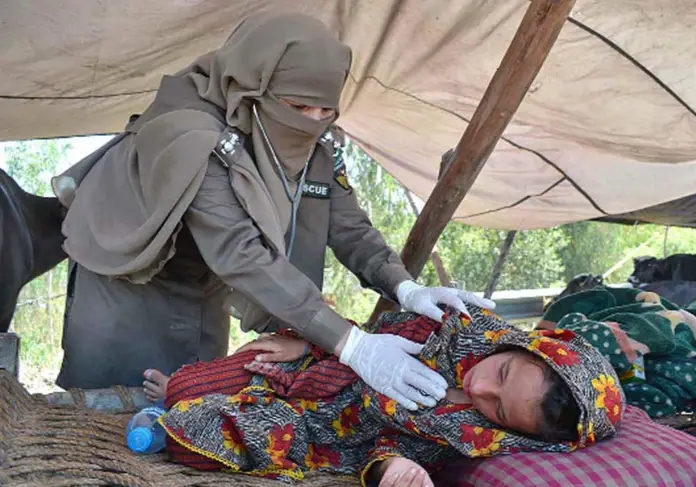The outbreak of water-borne diseases, including gastro, diarrhea, malaria and dengue fever claimed the lives of 18 more flood-affected people in Dadu, Larkana, Jamshoro, Shaheed Benazirabad, Khairpur, Qambar-Shahdadkot, Jaccobad, Ghotki, Naushahro Feroze and other flood-ravaged districts on Monday.
Meanwhile, five more persons drowned in different areas of the province. Several hundred people took out rallies and staged demonstrators in Sehwan, Dadu, Jhuddo, Pangrio, Khairpur, Qambar, Tangwani, Tando Bago, Badin, Jamshoro, New Saeedabad, Larkana, Kashmore, Dharki, Tando Mohammad and other towns to register their protest against the alleged indifference of the government high-ups towards their plight and their alleged failure to provide them with food, tents, safe drinking water, medicines, etc.
They said that they are facing hunger and starvation and their families are dying due to the outbreak of diseases.
They deplored that they are being forced to drink highly contaminated floodwater due to which they are facing various complications.
The high-ups of Sindh have completely failed out to drain out water from Jhuddo and outskirts and Hayat Khaskheli town in Badin district, which came under floodwater many weeks back.
A large number of residents of the submerged areas of Jhuddu, Naukot, Pangrio and several hundred villagers continued their protest on Thar Coal Road near Shadi Large Town for the fourth consecutive day, urging the authorities to cut the dykes of Left Bank Outfall Drain (LBOD) to drain out water.
The enraged people in Pangro town of Badin district attacked a truck loaded with relief goods and tried to loot it.
The police teams escorting the truck dispersed the unruly hungry people through baton-charge. Many of them were injured.
Meanwhile, the water level in the Manchhar Lake – one of the largest freshwater reserves of the country – further receded on Monday, with the officials expecting the situation to return to “complete normalcy”, provided that the water continued to flow to the River Indus without any disruption.
Irrigation engineer Mahesh Kumar told media persons that the water level in Manchhar had subsided to 120.7 feet but it needed to go down to 12 to 14 feet, which he said is its normal level. It is pertinent to mention here that the lake’s full capacity is 122.8 feet.
Kumar said the water was now flowing directly into the Indus River through the Larkana-Sehwan (LS) bund. He added that the water intensity at ring bunds at Mehar, Johi and Bhan Saeedabad was back to normal levels while the emergency declared previously there in view of raging water had now been lifted.







